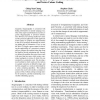Free Online Productivity Tools
i2Speak
i2Symbol
i2OCR
iTex2Img
iWeb2Print
iWeb2Shot
i2Type
iPdf2Split
iPdf2Merge
i2Bopomofo
i2Arabic
i2Style
i2Image
i2PDF
iLatex2Rtf
Sci2ools
EMNLP
2010
2010
Practical Linguistic Steganography Using Contextual Synonym Substitution and Vertex Colour Coding
Linguistic Steganography is concerned with hiding information in natural language text. One of the major transformations used in Linguistic Steganography is synonym substitution. However, few existing studies have studied the practical application of this approach. In this paper we propose two improvements to the use of synonym substitution for encoding hidden bits of information. First, we use the Web 1T Google n-gram corpus for checking the applicability of a synonym in context, and we evaluate this method using data from the SemEval lexical substitution task. Second, we address the problem that arises from words with more than one sense, which creates a potential ambiguity in terms of which bits are encoded by a particular word. We develop a novel method in which words are the vertices in a graph, synonyms are linked by edges, and the bits assigned to a word are determined by a vertex colouring algorithm. This method ensures that each word encodes a unique sequence of bits, without...
EMNLP 2010 | Linguistic Steganography | Natural Language Processing | SemEval Lexical Substitution | Synonym Substitution |
| Added | 11 Feb 2011 |
| Updated | 11 Feb 2011 |
| Type | Journal |
| Year | 2010 |
| Where | EMNLP |
| Authors | Ching-Yun Chang, Stephen Clark |
Comments (0)

